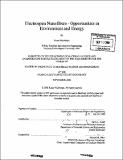Electrospun nanofibers : opportunities in environment and energy
Author(s)
Mukherjee, Kunal, Ph. D. Massachusetts Institute of Technology.
DownloadFull printable version (24.94Mb)
Other Contributors
Massachusetts Institute of Technology. Dept. of Materials Science and Engineering.
Advisor
Harry L. Tuller.
Terms of use
Metadata
Show full item recordAbstract
One-dimensional nanostructures have several attractive material properties compared to their bulk counterparts and have found applications in many novel devices. They have especially shown promise in the fields of renewable energy generation and environmental monitoring by improving solar cells and gas sensors. However difficulties in large scale manufacturing of these nanostructures have prevented most of these devices from entering the marketplace. Electrospinning is a simple, versatile and scalable technique to fabricate one-dimensional nanostructures in the form of nanofibers. It has recently been successfully used to produce semiconducting metal oxide nanofibers which have been used in chemiresistive gas sensors and dye-sensitized solar cells. Electrospun gas sensors and solar cells have already been shown to perform better than many of its competitors in a very short period of time. This coupled with low manufacturing costs and well protected intellectual property makes electrospinning a good candidate to bring the advantages of one-dimensional nanostructures into the marketplace.
Description
Thesis (M. Eng.)--Massachusetts Institute of Technology, Dept. of Materials Science and Engineering, 2008. Includes bibliographical references (leaves 53-56).
Date issued
2008Department
Massachusetts Institute of Technology. Department of Materials Science and EngineeringPublisher
Massachusetts Institute of Technology
Keywords
Materials Science and Engineering.